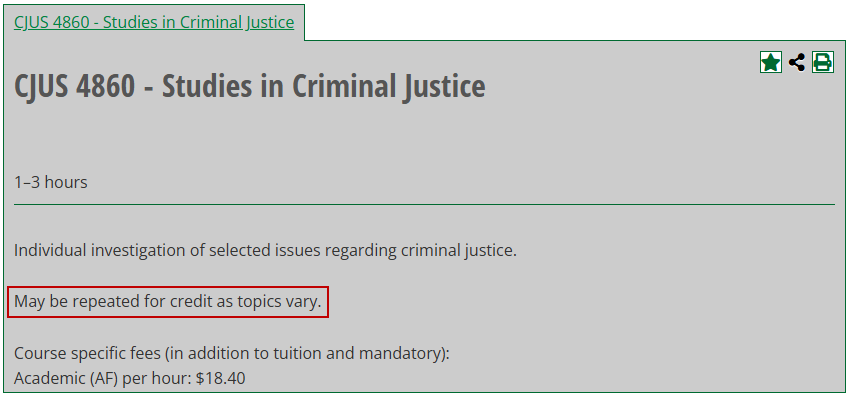Course Information
This section includes information about courses in relation to the degree audit. For instructions on how to access the degree audit, go to How to access your degree audit. You can also view this information as a PDF: Your Online Degree Audit.
Course Abbreviations on the Audit
Various course information is abbreviated on the audit: course terms, course levels, course grades and special codes for courses. For more information, expand each section below.
Course Terms
The term a course was taken is abbreviated into a number:
- The number before the decimal point is the last two digits of the year.
- The number after the decimal point represents the term:
- Spring: 1
- Summer: 3 to 6 (The specific number used may vary based on which summer session the course was taken in.)
- Fall: 8
- Wintermester: 12 (While wintermester at UNT is considered part of the Spring term, your audit may indicate wintermester courses separately.)
- Spring 2025: 1
- Summer 2025: 5
- Fall 2025: 8
- Wintermester 2025: 2512
- Note: Because the wintermester term is two digits, there is no decimal point between the year and the term for wintermester coursework.
When viewing your course information on the ‘Courses’ tab, the term may be shown as a 6-digit number, comprised of the 4-digit year and the 2-digit term the course was taken.
Course Levels
The first number after the course prefix indicates the level of the course:
- 0 – Developmental coursework
- 1 – Lower-level coursework
- 2 – Lower-level coursework
- 3 – Upper-level (advanced) coursework
- 4 – Upper-level (advanced) coursework
- 5 – Graduate-level coursework
- 6 – Graduate-level coursework
- 8 – Technical coursework. May not count toward degree requirements, depending on your program.
- 9 – Unevaluated transfer coursework. May not count toward degree requirements until evaluated by an advisor.
Course Grades
Grades used on the degree audit include the following:
- Letter grades A, B, C, D and F
- EN – Enrolled (no GPA impact)
- CR – Credit, non-traditional (no GPA impact)
- Note: CR grades are often used for test credit.
- P – Pass (no GPA impact)
- NP – No Pass (no GPA impact)
- PR – In progress, thesis and dissertation only (no GPA impact)
- NPR – No progress, thesis and dissertation only (no GPA impact)
- W – Withdraw (no GPA impact)
- WF – Withdraw Failing – Note: Use discontinued fall 2018 (treated as ‘F’ in GPA)
- I – Incomplete (no GPA impact)
- ?? – Transfer grade not defined – Contact advisor for assistance (no GPA impact until grade is updated)
- Z – No grade reported – Contact instructor for assistance (no GPA impact until grade is updated)
Note: For the full definition for each grade, refer to the UNT Catalog.
Special Codes on the Audit
Special codes are used on the degree audit to provide additional information about a course:
- IP – In progress
- >R – Repeatable for credit
- RX – Duplicate course (Repeat-Exclude) – Does not count in GPA, toward graduation / earned hours or attempted hours (first attempt)
- DP – Duplicate course (Duplication) – Counts in GPA and attempted hours, does not count toward graduation / earned hours (“in-between” attempts)
- RC – Duplicate course (Repeat-Count) – Counts toward graduation / earned hours and counts in GPA and attempted hours (final attempt)
Note: Duplicate courses are processed differently in myUNT and for your transcript. For information about how course duplications are processed for your transcript, refer to the UNT Catalog.
Course duplications
Course duplications occur when a student takes any course—that is not designated as repeatable—again after completing it once. The Repeated Course Tuition for undergraduate students applies to course duplications. For information about duplications, see the UNT Catalog.
Repeatable courses
Courses designated as repeatable include courses for which the content changes each time the course is taught, such as special topics, music performance and studio arts courses. You can confirm if a course is repeatable by checking the course description in the UNT Catalog.

Certain repeatable courses have limits on the number of times a student can take the course before duplications will start to be processed. Here are a couple of examples:
- A course states, “May be repeated for credit as topics vary.” Since no limit is specified, students can take this course any number of times without the credit being processed as a duplication.
- A 3-credit hour course states, “May be repeated for credit, a maximum of 6 credit hours.” For this course, students can only take it twice (because it is a 3-hour course) for credit. After receiving 6 hours for this course, any additional attempts will be processed as duplications.
Graduate Coursework
Graduate Courses on Undergraduate Audits
Graduate-level courses are typically suppressed and do not appear on undergraduate audits. However, graduate courses taken for a Grad Track program should appear on audits that have a Grad Track option. For some Grad Track programs, the graduate courses will plug into the appropriate requirements automatically. For other Grad Track programs, they will need to be manually plugged in by an advisor.
Note: If you are in a Grad Track program and your Grad Track courses do not appear anywhere on your undergraduate audit, please contact your advisor. Your audit may be reading the courses as regular graduate-level courses, instead of graduate courses taken for a Grad Track program. Please contact your advisor for assistance.
Graduate Transfer Credit
Students in graduate programs must request to have graduate transfer credit posted. Please contact your advisor for more information.
For more information about courses, please refer to the UNT Catalog.